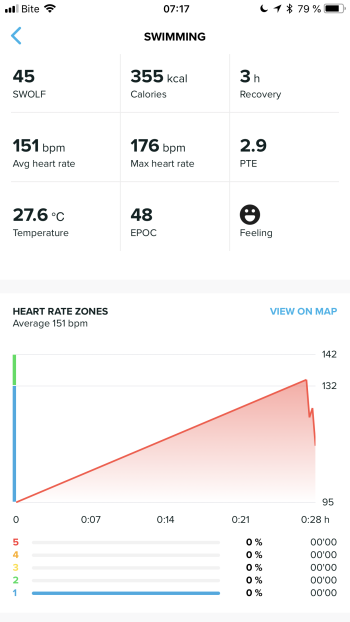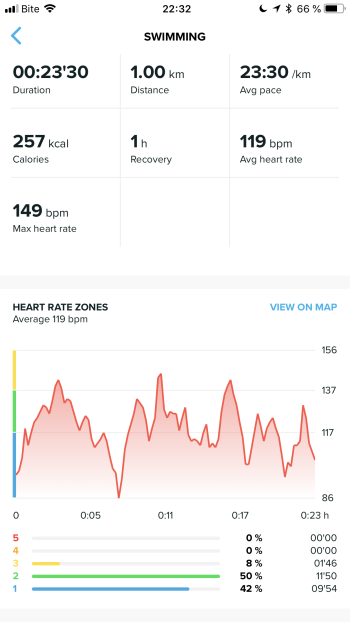Smart sensor
-
Hello, I am writing through the translator googel, sorry for mistakes. I bought Suunto 9 with the hope that the problem with the HR sensor will disappear. Unfortunately, the problem still exists. I replaced the elastic strap with a new one, I used it for 7 days and now erroneous readings have appeared during running. The heart rate jumps as if it’s twisted. Tomorrow I am sending the HR sensor to Suunto with the complaint. We’ll see what they’ll do. I will be using the HR sensor from Decatlon for 30 USD with my new Sunnto 9.
 I am tired of this situation, I swim in the pool and the lake irritates me that the HR sensor is defective and other sensors do not work while swimming.
I am tired of this situation, I swim in the pool and the lake irritates me that the HR sensor is defective and other sensors do not work while swimming. -
@Michał-Muszyński
@Yannis-Belouris said in Smart sensor:@borgelkranz said in Smart sensor:
@fleshymutant @Brad_Olwin My problems with the Suunto belts were history once i started to clean them as described here.
Basically, after each excercise you put the belt in a sink, fill the sink with warm water while washing your hands and let the belt soak for a while. Rinse it off and let it dry.
Cleaning the belt in the washing machine worns it out. Killed one in roughly six month doing this…
This is absolutely true.
I leave it overnight in a small bucket with 2 drops of dish washing detergent and just leave it to dry when I wake up.
Washing in the washing machine has mixed results due to stronger detergent and potential use of softener. -
@Michał-Muszyński said in Smart sensor:
Hello, I am writing through the translator googel, sorry for mistakes. I bought Suunto 9 with the hope that the problem with the HR sensor will disappear. Unfortunately, the problem still exists. I replaced the elastic strap with a new one, I used it for 7 days and now erroneous readings have appeared during running. The heart rate jumps as if it’s twisted. Tomorrow I am sending the HR sensor to Suunto with the complaint. We’ll see what they’ll do. I will be using the HR sensor from Decatlon for 30 USD with my new Sunnto 9.
 I am tired of this situation, I swim in the pool and the lake irritates me that the HR sensor is defective and other sensors do not work while swimming.
I am tired of this situation, I swim in the pool and the lake irritates me that the HR sensor is defective and other sensors do not work while swimming.Hi Michał: I swim with my 9 and the Suunto Smart sensor and it’s fine, as long as I don’t drive incredibly hard at the beginning of the length (all belts have this problem). I wet the strap before I put it on, as they stretch by ~30% when wet, and just before I start swimming it feels very tight. After that, it’s fine, and I get good, clean HR data. I blogged about it a bit here: https://t.co/KOJhi6CQlb
Regarding the optical sensor, the consensus is that if one is serious about HR data, one uses a chest strap. Optical isn’t good for applications where there’s movement, and the water buffeting the watch with each stroke definitely counts as movement. I really like optical for background monitoring - sleeping, for example, or perhaps hiking - but for everything else I always use a chest strap, or an optical that’s not on my wrist (Wahoo TICKR FIT, or the Schosche (sp?) Rhythm 24, or the Polar OH1, for example).
Smooth swimming!
-
@Ze-Stuart but your hr looks really funky if it is belt…
-
@SlaSh said in Smart sensor:
@Ze-Stuart but your hr looks really funky if it is belt…
It corresponds to when I’m swimming front crawl, which for me is a lot like trying not to drown, and when I’m swimming breast stroke, which is a lot more comfortable. The big gap is when I’ve decided to stop drowning simulations, and take in the view of the pool… Here’s today’s swim, which I think is easier to interpret:

I think the initial drop is the mammalian reflex (drop in HR upon face immersion), and then I swam 6 lengths of crawl, 6 or so of breast stroke, then alternated for the rest of the swim, until the end when I did two of crawl. I was using a PowerBreather snorkel today, so no drowning simulation!
-
@Ze-Stuart below graph is from SA and looks terrible, I don’t see value from Powerbreather when doing breaststroke as breathing is quite easy in that style, but in freestyle it would benefit.

-
@Michał-Muszyński Suunto has acknowledged a software issue with the sensor. I am not having issues but some are. Fix hopefully soon
-
Is there a way of telling Spartan Wrist HR to disconnect the Smart Sensor after a workout? Other than unpairing it? Seems like mine stays on for a good while even after unplugging it from the belt and placing the sensor on a table. While the connection is active, the watch refuses to measure HR with the optics. Optimal solution would be to have an option to select which HR sensor to use, or if any.
-
@SlaSh that bug is also present in the watch; there’s a thread about it… somewhere!
-
Maybe it helps:
When using the sensor in the water please:
- Start the excersise when the sensor is connected and shows HR working. If not done like this it will use OHR and will not send the command to the HR sensor to record.
- When ending the excersise do not do in water. Get out or make sure sensor + watch are out of the water and the watch has HR signal. For example when done, press pause, get out of the water, switch the screens on the pause to see the live HR. Then press end. The watch will pull the recorded HR from the sensor (also does it while paused).
I hope this helps
-
@Ze-Stuart this is your swim workout screenshot

-
@SlaSh I know, I recognise the bad data…
@Dimitrios-Kanellopoulos superb, basic steps.
-
@Ze-Stuart every your swim looks like this
 so ohrm even works better than your chest strap
so ohrm even works better than your chest strap 
-
@SlaSh only in the app… even when I threaten to bite it. (I think Mr. @Dimitrios-Kanellopoulos said it was fixed in an upcoming release, actually, and the whole thing is an interesting insight into how the two discrete data channels are bonded into one.)
-
@Ze-Stuart it is strange situation as swim with ohrm displayed fine…
-
-
@Dimitrios-Kanellopoulos quite strange situation how same application on different OS is acting…But how come HR with OHRM is shown fine even on iOS app?

-
@slash that is a good question I can answer.
Some belts and OHRs have the ability to send IBI data to the watch.
IBI stands for interbeat interval, known as R-R as well.
This is the time, usually in milliseconds, between to beats.IBI is the mother of HR. All belts/etc that report HR ONLY so some processing on an IBI set buffer.
Good to know:
HR is actually a “stupid” value as it lets you see the value of Beats Per Minute but you update it every 1s. Now add to that that 1s can contain even one beat (60BPM) the more low you drop the more hard it gets as of time needed to calculate. If for example the HR is < 60 BPM, lets say 30bpm imagine that every 2 seconds you get a beat. Anyways you can take a look in this section to know more if youlikeTo cut a long story short someone has to process the IBI and derive an HR for the user.
Since IBI is stored on the watch and not HR if not from OHR, then the app, fails to process that. Why I do not know.I have implemented the IBI data in my app(quantify-self not Suunto ) and feel free to ask any questions about. Just for the record, I had to study and experiment for 2 weeks longs to be able to give a correct result.
-
@SlaSh said in Smart sensor:
But how come HR with OHRM is shown fine even on iOS app?
Here’s what I think is happening with my swim: I record using a chest strap, which means that the two data streams - swim data from watch, and HR data from strap - have to be incorporated into one. The summary on the watch is always wrong, and mirrors what we see in the app, which makes me think the app pulls the watch’s summary. Movescount, on the other hand, shows correct data: I think because it either re-analyses the data from the watch, or, because there are two discrete files (HR and swim data) that it recombines and aligns.
When you record HR with the HRM in the watch, the data is recorded live, hence the data in the app is correct. Unless, of course, I misunderstood and the OHRM you’re talking about is an external one, and that would explain why @Dimitrios-Kanellopoulos has his comment about HRV (which he’s right, is the interesting, juicy, high-resolution HR data we truly want).
I have a ticket with Suunto about incorrect watch summaries, which they’ve sent off to Finland.
-
OHRM should stand for Optical Heart Rate Monitoring, so the watch
And it should be this case as the other sensor involved is the belt one … as far as I understood
